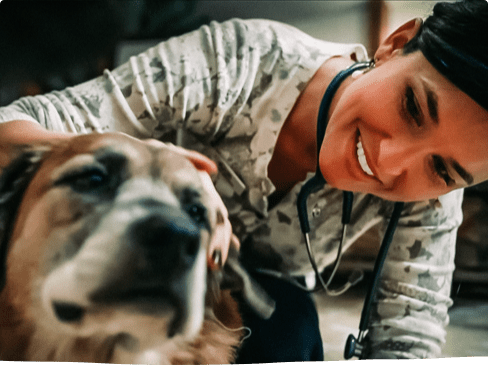by Dr. Dani McVety, Founder and CEO of Lap of Love Veterinary Hospice.
Mobility issues are the most common of all problems reported to us by dog owners. At least 50% of our patients struggle with some level of mobility difficulty. By a wide margin, the number-one reported ailment from pet owners in my line of work, which is veterinary hospice care, is that their pet is having difficulty with mobility. These issues range from struggling to stand, splaying while at their food bowl, or, in some cases, the complete inability to walk. Osteoarthritis is the most common cause of mobility issues in geriatric pets, but soft tissue injuries, disc disorders, stenosis, and neuropathy also could be the root of the issue.
Mobility can be affected by arthritis, other musculoskeletal changes, and sarcopenia—an under-diagnosed condition in which aging animals progressively lose lean body mass in the absence of disease. As muscle tissue mass decreases, so does muscle strength, which is why older humans are less steady or have difficulty catching their balance. Pets may exhibit analogous signs, such as changes in their movements, reflected in difficulty in rising or reluctance to jump. Tile or wood floors can become an unmanageable “ice rink” to these pets.
Mobility problems need to be addressed before the pet becomes immobile, at which point, there is much less that can be done. Besides pain management or prescribing other medications as needed, there are many things we can recommend to help pets with mobility issues. You can book a pet physical therapist on Petworks.
MOBILITY TIPS
1. Place bath or yoga mats around the house where the pet travels most; the stability they provide gives mental relief to pets.
2. Stairs can be difficult for geriatric pets, especially for dogs with arthritis. If you have a multi-story home, make the bottom level your senior pet’s “home” so that they don’t have to go up the stairs too often. If they can’t avoid steps or a staircase, make sure there is good enough traction or that you can assist them. Use ramps, which, even on the smallest number of steps, provide great relief to arthritic dogs. One step can trip a pet; therefore, owners should not overlook single steps out of a doggy door or off the porch. Sometimes you do need to limit access. Stairs can be dangerous for weak or visually impaired pets to navigate. Blocking off stairs and other high-risk spots with gates or tension rods can prevent unnecessary injuries. For dogs and cats that like to jump on the bed or couch but can’t quite make it anymore, a step, a ramp, or a small set of stairs can give them the assistance they need to reach a well-loved space.
3. A well-fitted and properly supporting harness that remains on the dog most of the day can be incredibly beneficial. These devices also help with owner fatigue from lifting larger dogs. My personal favorite is the Help ’Em Up harness, which provides an equal distribution of lifting assistance for both male and female dogs. (See Recommended Products below) Many other harnesses simply focus on lifting from the abdomen, but this can cause strain on organs and the iliopsoas muscle, which is often tender.
4. Did you know your pet’s fur can affect their mobility as they age? Many “furry” dogs get a lot of hair between their toes. The extra fluff is similar to wearing furry socks, which can lead to more slips. Use a beard clipper to remove the hair around their toes to expose their pads so they can walk with better traction. Use booties with a non-slip surface, which can be very helpful once the pet acclimates to them. Be sure to remove them twice a day and at night and to avoid putting them on too tight.
5. Use wagons for walks, which allows dogs with limited mobility to enjoy walks. Once the pet has arrived at a safe spot, he can get out and enjoy “sniff” time; then the wagon is ready for the walk home.
6. Finally, exercise remains important to maintain a pet’s strength and flexibility. Keep pets moving. Pet owners should continue to exercise their pets within set boundaries. Lack of movement only exacerbates the issues of decline. Walks and active playtime may need to be reduced, but it’s vital these pets still go outside. Getting out is not only good for the body—it’s great for the soul, as well.
About the Author
 In addition to her role as a hospice veterinarian and Founder & CEO of Lap of Love, Dani McVety is a speaker, consultant, author, and host for PetCareTV. With a deep love for the human-animal bond, Dr. Dani enjoys just about anything that has to do with pets! After graduating from college, she practiced emergency medicine and gained a greater understanding of how to help families at a time in which they felt most helpless. This has become her greatest fulfillment in veterinary medicine: helping to ease the stress and fear of the people who love their animals. Already an accomplished entrepreneur before vet school graduation, Dr. Dani partnered with Dr. Mary Gardner about one year after founding Lap of Love. Together they have grown the company into one of the most respected networks of doctors in the veterinary profession, setting the standard for end-of-life care higher than it has ever been before. Dr. Dani graduated from the University of Florida College of Veterinary Medicine and is the youngest recipient of the college’s Distinguished Young Alumni Award (2013), the Florida Veterinary Medical Association’s President’s Award (2014), and most recently, the Pet Industry Woman of the Year (2017).
In addition to her role as a hospice veterinarian and Founder & CEO of Lap of Love, Dani McVety is a speaker, consultant, author, and host for PetCareTV. With a deep love for the human-animal bond, Dr. Dani enjoys just about anything that has to do with pets! After graduating from college, she practiced emergency medicine and gained a greater understanding of how to help families at a time in which they felt most helpless. This has become her greatest fulfillment in veterinary medicine: helping to ease the stress and fear of the people who love their animals. Already an accomplished entrepreneur before vet school graduation, Dr. Dani partnered with Dr. Mary Gardner about one year after founding Lap of Love. Together they have grown the company into one of the most respected networks of doctors in the veterinary profession, setting the standard for end-of-life care higher than it has ever been before. Dr. Dani graduated from the University of Florida College of Veterinary Medicine and is the youngest recipient of the college’s Distinguished Young Alumni Award (2013), the Florida Veterinary Medical Association’s President’s Award (2014), and most recently, the Pet Industry Woman of the Year (2017).


